Human Perceptuality-Aware Tone-Mapping-Based Dynamic Voltage Scaling for an AMOLED Display Smartphone
Abstract
1. Introduction
- Compared to prior work, a DVS technique which targets tone-mapped images on the smartphone is proposed for the first time.
- In order to consider power saving as well as image quality, Reinhard TMO is modified and applied to DVS together with unsharp masking.
- Runtime image quality control is performed at the HAL level of the Android platform based on the results from the user study.
2. Background and Related Work
2.1. HDR Images on LDR Displays
2.2. Related Work
3. Motivational Studies
4. Design of Tone-Mapping-Based DVS
4.1. Unsharp Masking for Smartphones
4.2. Modified Tone-Mapping Operator
4.3. Measuring Human Perceptuality
4.4. Tone-Mapping-Based DVS Scheme
5. Experiments and Results
5.1. Experimental Setup
5.2. Experimental Results
6. Conclusions
Author Contributions
Funding
Informed Consent Statement
Conflicts of Interest
References
- BCC: UHD Display Market Worth $132bn by 2022. Available online: https://advanced-television.com/2018/02/21/bcc-uhd-display-market-worth-132bn-by-2022/Powerguru (accessed on 12 February 2020).
- The Biggest “Emerging” Tech Product of 2018? 4K TVs. Available online: https://www.flatpanelshd.com/news.php?subaction=showfull&id=1516272294 (accessed on 12 February 2020).
- IHS Study: 4K Ultra HD HDR To Take Major TV Market Share By 2020. Available online: https://hdguru.com/ihs-study-4k-ultra-hd-hdr-to-take-major-tv-market-share-by-2020/ (accessed on 12 February 2020).
- Arm Announces Mali-D71 for 4K/120 Hz Displays, Assertive Display 5 with HDR. Available online: https://www.cnx-software.com/2017/11/01/arm-announces-mali-d71-for-4k120-hz-displays-assertive-display-5-with-hdr/ (accessed on 12 February 2020).
- Chen, X.; Chen, Y.; Ma, Z.; Felix, C.A.F. How is energy consumed in smartphone display applications? In Proceedings of the 14th Workshop on Mobile Computing Systems and Applications (HotMobile ’13); ACM: New York, NY, USA, 2013. [Google Scholar]
- UHD TVs Consume 3x More Power Than HD. Available online: http://advanced-television.com/2015/11/20/uhd-tvs-consume-3x-more-power-than-hd/ (accessed on 12 February 2020).
- Available online: https://www.gsmarena.com/samsung_galaxy_s_iii_vs_galaxy_note_ii-review-830p2.php (accessed on 12 February 2020).
- Available online: https://www.phonearena.com/news/Outdoor-display-comparison-iPhone-6s-vs-S7-edge-vs-10-vs-G5_id81070 (accessed on 12 February 2020).
- Sony’s Latest Flagship Smartphone Shoots 4K HDR Video. Available online: http://fortune.com/2018/02/26/sonys-xperia-xz2-4k-hdr-mobile-world-congress-barcelona/ (accessed on 12 February 2020).
- Reinhard, E.; Valenzise, G.; Dufaux, F. “High Dynamic Range Video”, Tutorial. In Proceedings of the Eusipco2016, Budapest, Hungary, 29 August–2 September 2016. [Google Scholar]
- Cerda-Company, X.; Parraga, C.A.; Otazu, X. Which tone-mapping operator is the best? A comparative study of perceptual quality. J. Opt. Soc. Am. A 2018, 35, 626–638. [Google Scholar] [CrossRef] [PubMed]
- Reinhard, E.; Stark, M.; Shirley, P.; Ferwerda, J. Photographic tone reproduction for digital images. ACM Trans. Graph. 2002, 21, 267–276. [Google Scholar] [CrossRef]
- Aydin, T.O.; Mantiuk, R.; Myszkowski, K.; Seidel, H.-P. Dynamic range independent image quality assessment. In ACM SIGGRAPH 2008 Papers (SIGGRAPH ’08); ACM: New York, NY, USA, 2008; 10p. [Google Scholar] [CrossRef]
- Shin, D.; Kim, Y.; Chang, N.; Pedram, M. Dynamic Driver Supply Voltage Scaling for Organic Light Emitting Diode Displays. IEEE Trans. Comput. Des. Integr. Circuits Syst. 2013, 32, 1017–1030. [Google Scholar] [CrossRef]
- Park, J.-H.; Maregn, Z.; Kim, Y.-J. Color transformation-based dynamic voltage scaling for mobile AMOLED displays. IEICE Electron. Express 2015, 12, 20150239. [Google Scholar] [CrossRef][Green Version]
- Lee, B.-H.; Kim, Y.-J. Dynamic Voltage Scaling Using Scene Change Detection for Video Playback on Mobile AMOLED Displays. In Proceedings of the 2016 IEEE/ACM International Symposium on Low Power Electronics and Design (ISLPED), San Francisco, CA, USA, 8–10 August 2016. [Google Scholar]
- Hong, S.; Kim, S.-W.; Kim, Y.-J. LGC-DVS: Local Gamma Correction-Based Dynamic Voltage Scaling for Android Smartphones with AMOLED Displays. IEEE J. Electron Devices Soc. 2017, 5, 432–444. [Google Scholar] [CrossRef]
- He, S.; Liu, Y.; Zhou, H. Optimizing Smartphone Power Consumption through Dynamic Resolution Scaling. In Proceedings of the 21st Annual International Conference on Mobile Computing and Networking (MobiCom ’15); ACM: New York, NY, USA, 2015; pp. 27–39. [Google Scholar] [CrossRef]
- Hwang, C.; Pushp, S.; Koh, C.; Yoon, J.; Liu, Y.; Choi, S.; Song, J. RAVEN: Perception-aware Optimization of Power Consumption for Mobile Games (MobiCom ’17). In Proceedings of the 23rd Annual International Conference on Mobile Computing and Networking, Snowbird, UT, USA, 16–20 October 2017; pp. 422–434. [Google Scholar] [CrossRef]
- Kim, D.; Jung, N.; Chon, Y.; Cha, H. Content-Centric Energy Management of Mobile Displays. IEEE Trans. Mob. Comput. 2015, 15, 1925–1938. [Google Scholar] [CrossRef]
- Yan, Z.; Chen, C.W. Too Many Pixels to Perceive: Subpixel Shutoff for Display Energy Reduction on OLED Smartphones. In Proceedings of the 2017 ACM on Multimedia Conference (MM ’17); ACM: New York, NY, USA, 2017; pp. 717–725. [Google Scholar]
- Jin, J.-C.; Lee, J.-H.; Kim, E.-S.; Kim, Y.-J. OPT: Optimal human visual system-aware and power-saving color transformation for mobile AMOLED displays. Multimedia Tools Appl. 2017, 77, 16699–16720. [Google Scholar] [CrossRef]
- Anand, B.; Kecen, L.; Ananda, A.L. PARVAI—HVS aware adaptive display power management for mobile games. In Proceedings of the IEEE International Conference on Mobile Computing and Ubiquitous Networking, Singapore, 6–8 January 2014; pp. 21–26. [Google Scholar]
- Wang, Z.; Bovik, A.C.; Sheikh, H.R.; Simoncelli, E.P. Image quality assessment: From error visibility to structural similarity. IEEE Trans. Image Process. 2004, 13, 600–612. [Google Scholar] [CrossRef] [PubMed]
- Lin, C.-H.; Kang, C.-K.; Hsiu, P.-C. Catch your attention: Quality-retaining power saving on mobile OLED displays. In Proceedings of the 2014 51st DAC/IEEE Design Automation Conference (DAC), San Francisco, CA, USA, 1–5 June 2014; pp. 1–6. [Google Scholar]
- Iranli, A.; Pedram, M. DTM: Dynamic tone mapping for backlight scaling. In Proceedings of the 42nd annual Design Automation Conference (DAC ’05); ACM: New York, NY, USA, 2005; pp. 612–617. [Google Scholar] [CrossRef]
- Chen, X.; Chen, Y.; Xue, C.J. DaTuM: Dynamic tone mapping technique for OLED display power saving based on video classification. In Proceedings of the 2015 52nd ACM/EDAC/IEEE Design Automation Conference (DAC), San Francisco, CA, USA, 8–12 June 2015; pp. 1–6. [Google Scholar]
- Drago, F.; Myszkowski, K.; Annen, T.; Chiba, N. Adaptive Logarithmic Mapping for Displaying High Contrast Scenes. Comput. Graph. Forum 2003, 22, 419–426. [Google Scholar] [CrossRef]
- Shiga, T.; Kitahara, S. Power Reduction of OLED Displays by Tone Mapping Based on Helmholtz-Kohlrausch Effect. IEICE Trans. Electron. 2017, E100.C, 1026–1030. [Google Scholar] [CrossRef]
- Anand, B. Adaptive Video Content Manipulation for OLED Display Power Management. In Proceedings of the 15th EAI In-ternational Conference on Mobile and Ubiquitous Systems: Computing, Networking and Services, New York, NY, USA, 5–7 November 2018; pp. 236–245. [Google Scholar]
- Samsung Galaxy S3. Available online: http://www.gsmarena.com/sam-sung_i9305_galaxy_s_iii-5001.php (accessed on 30 August 2017).
- Yeganeh, H.; Wang, Z. Objective Quality Assessment of Tone-Mapped Images. IEEE Trans. Image Process. 2012, 22, 657–667. [Google Scholar] [CrossRef] [PubMed]
- Badamchizadeh, M.A.; Aghagolzadeh, A. Comparative study of unsharp masking methods for image enhancement. In Proceedings of the Third International Conference on Image and Graphics, Hong Kong, China, 18–20 December 2004; pp. 27–30. [Google Scholar]
- Gill, J.; Girdhar, A.; Singh, T. A Review of Enhancement and Segmentation Techniques for Digital Images. Int. J. Image Graph. 2019, 19. [Google Scholar] [CrossRef]
- Fisher, B.; Perkins, S.; Walker, A.; Wolfart, E. Laplacian/Laplacian of Gaussian. In Hypermedia Image Processing Reference; Department of Artificial Intelligence, University of Edinburgh: Edinburgh, UK, 2001. [Google Scholar]
- Marr, D.; Hildreth, E. Theory of edge detection. Proc. R. Soc. Lond. Ser. B 1980, 207, 187–217. [Google Scholar]
- Ansari, M.A.; Kurchaniya, D.; Dixit, M. A Comprehensive Analysis of Image Edge Detection Techniques. Int. J. Multimedia Ubiquitous Eng. 2017, 12, 1–12. [Google Scholar] [CrossRef]
- Neycenssac, F. Contrast Enhancement using the Laplacian-of-a-GaussianFilter. CVGIP Graph. Models Image Process. 1993, 55, 447–463. [Google Scholar] [CrossRef]
- Krasula, L.; Narwaria, M.; Fliegel, K.; Le Callet, P. Influence of HDR reference on observers preference in tone-mapped images evaluation. In Proceedings of the 2015 Seventh International Workshop on Quality of Multimedia Experience (QoMEX), Messinia, Greece, 26–29 May 2015; pp. 1–6. [Google Scholar] [CrossRef]
- Hiromi, N. Visual attention in LDR and HDR images. In Proceedings of the 9th International Workshop on Video Processing and Quality Metrics for Consumer Electronics (VPQM), Chandler, AZ, USA, 5–6 February 2015. [Google Scholar]
- Monsoon Solutions Inc. Available online: http://www.msoon.com/LabEquipment/PowerMonitor/ (accessed on 30 August 2017).
- Sheikh, L.C.H.R.; Wang, Z.; Bovik, A.C. Live Image Quality Assessment Database Release 2. Available online: http://live.ece.utexas.edu/ (accessed on 12 February 2020).
- McCamy, C.S.; Marcus, H.; Davidson, J.G. A Color-Rendition Chart. J. Appl. Photogr. Eng. 1976, 2, 95–99. [Google Scholar]
- Display Color Analyzer CA-410—Konica Minolta. Available online: https://www.konicaminolta.com/instruments/download/instruction_manual/display/pdf/ca-410_instruction_probe-software_eng.pdf (accessed on 24 April 2021).
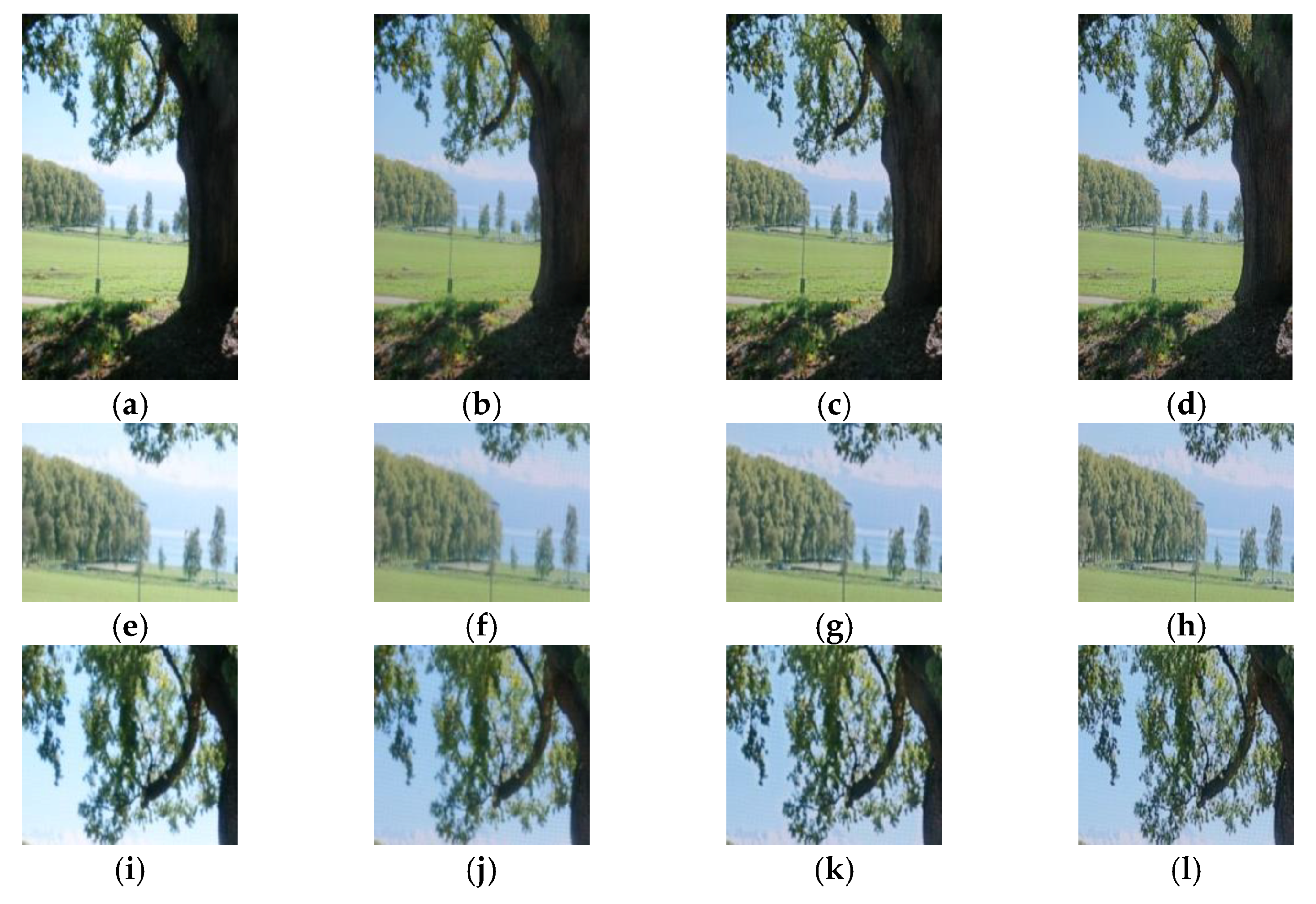
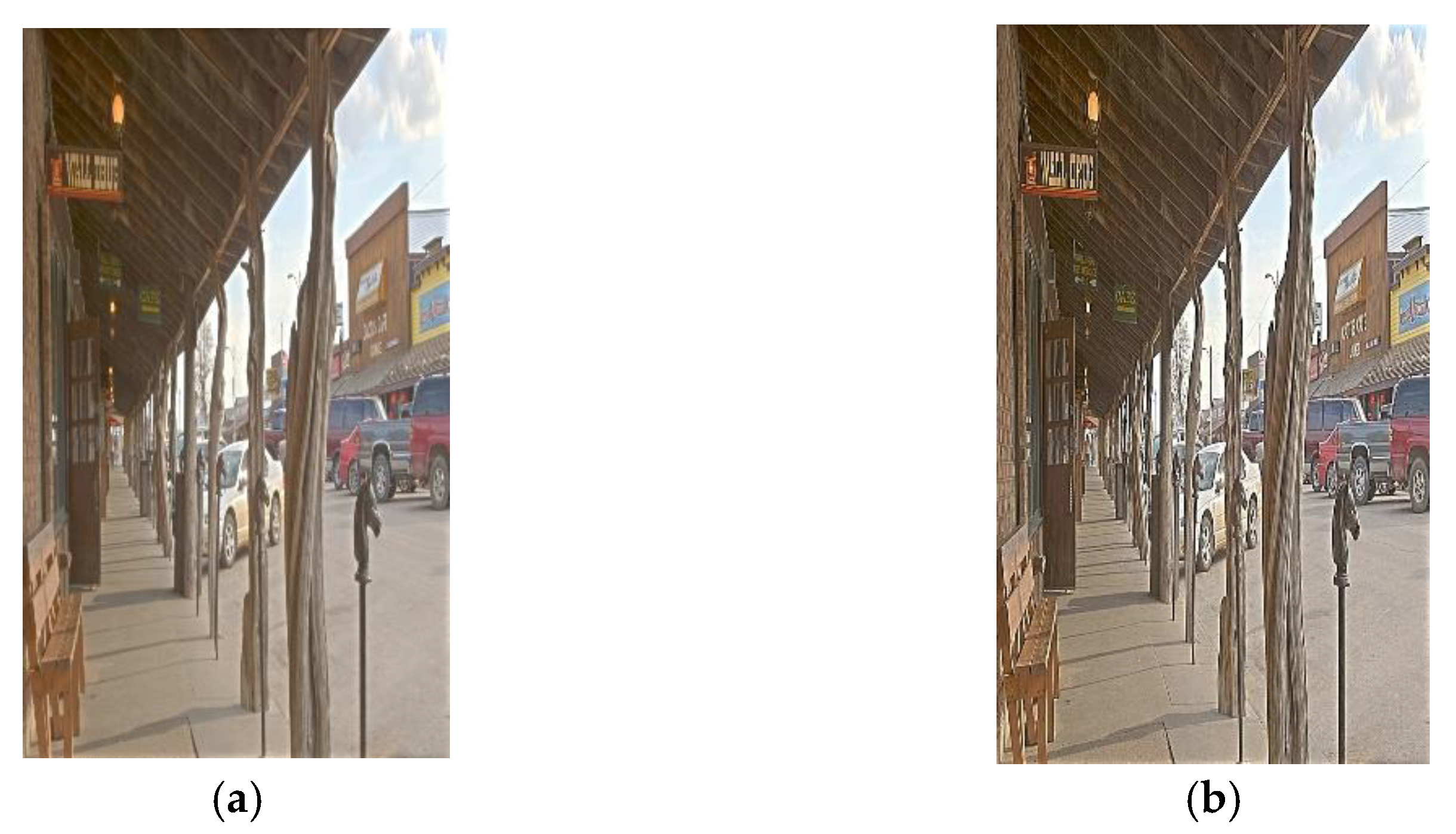
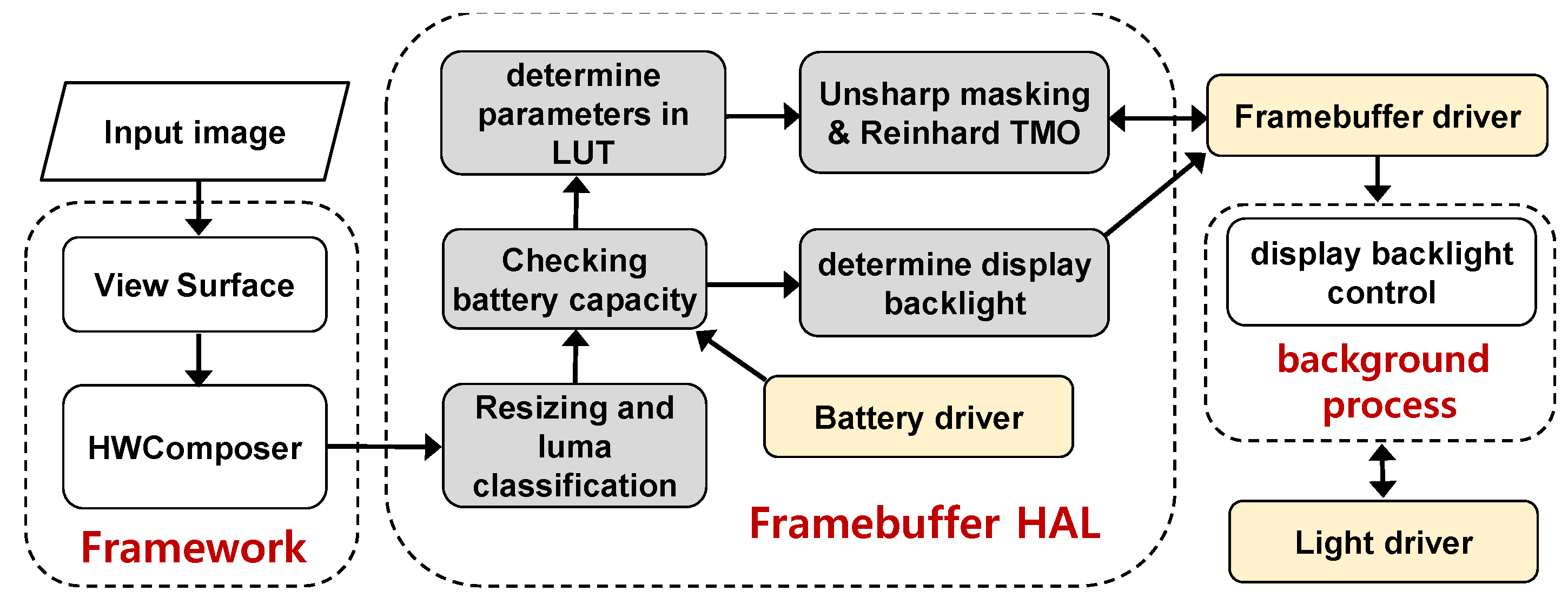
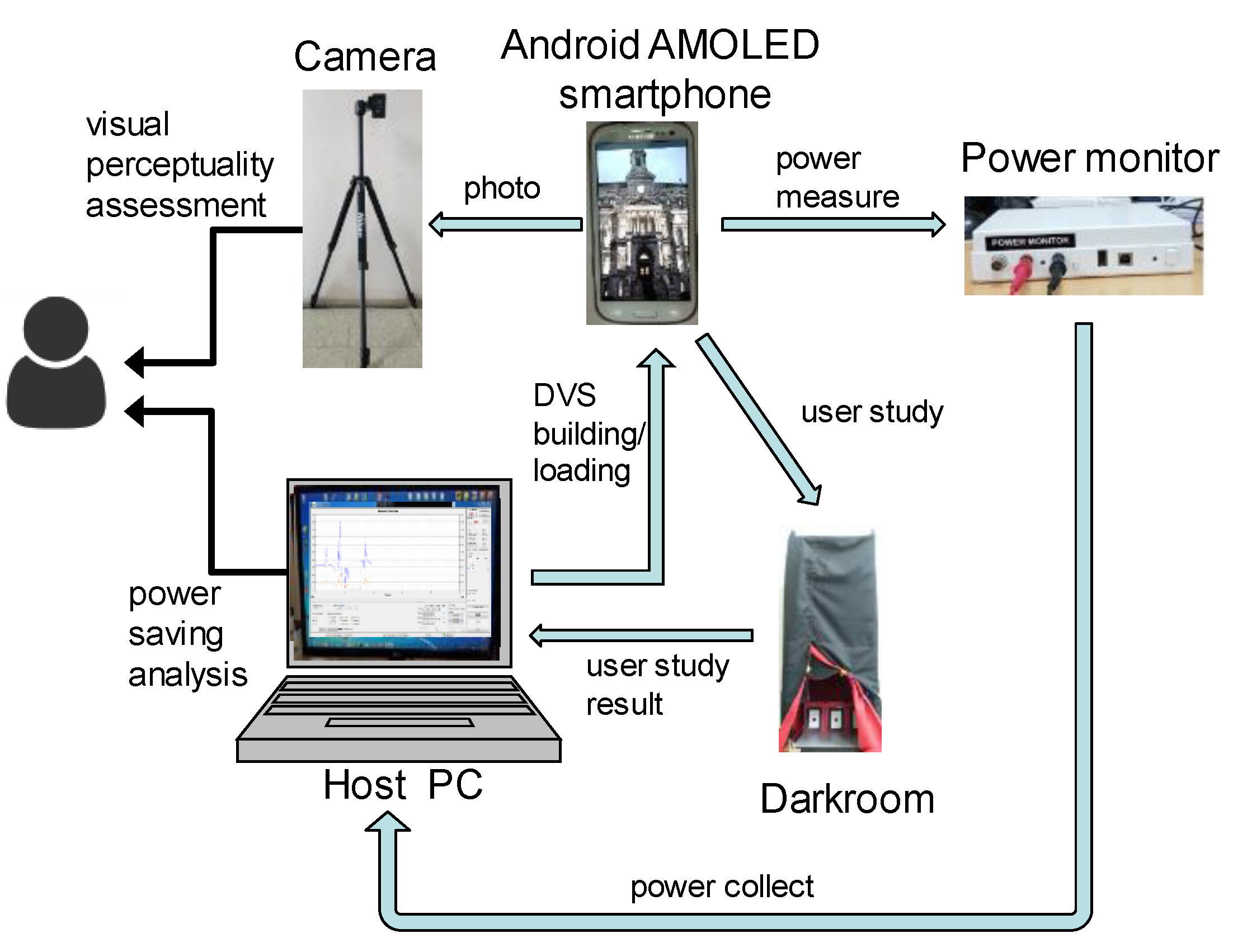
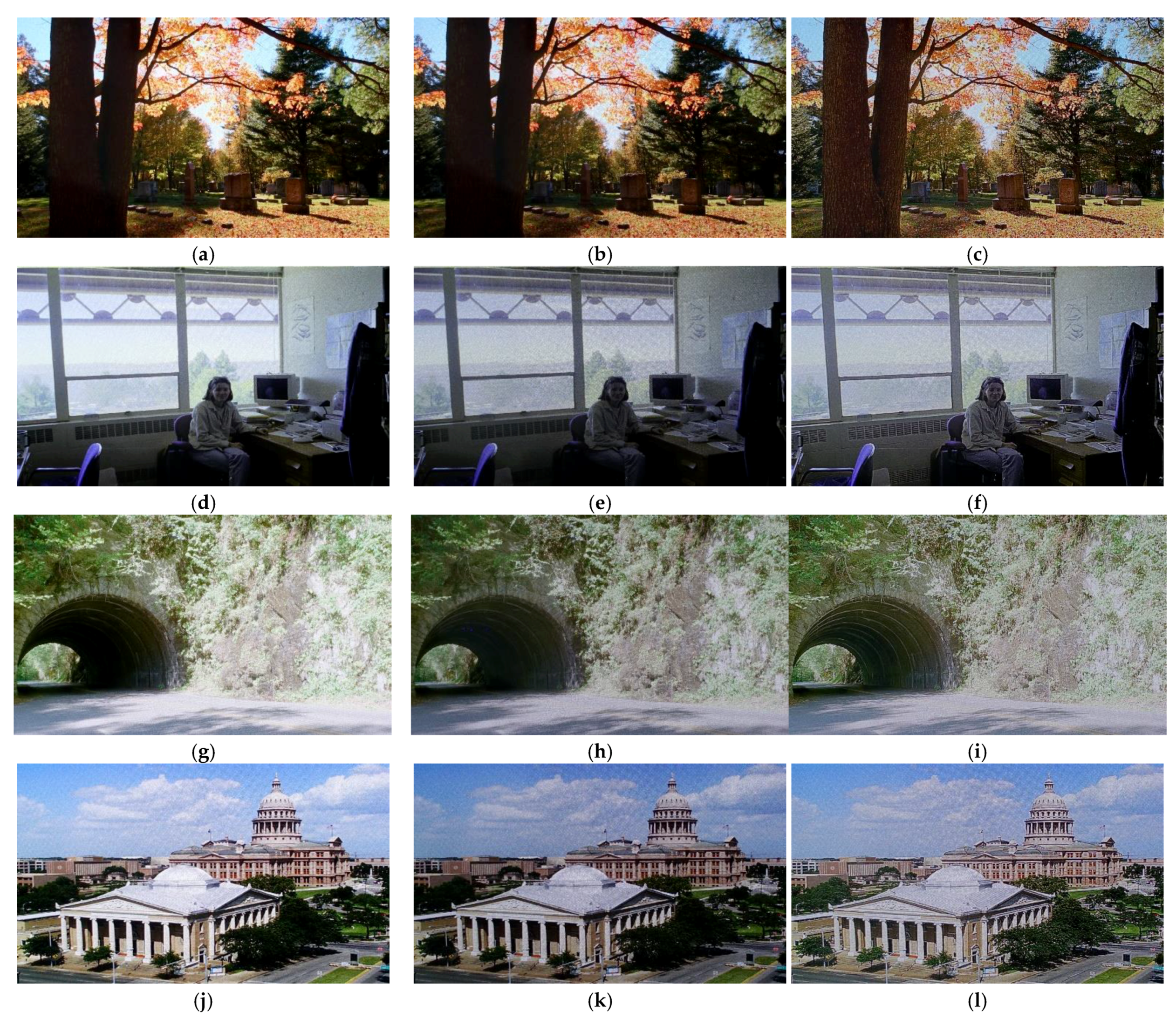
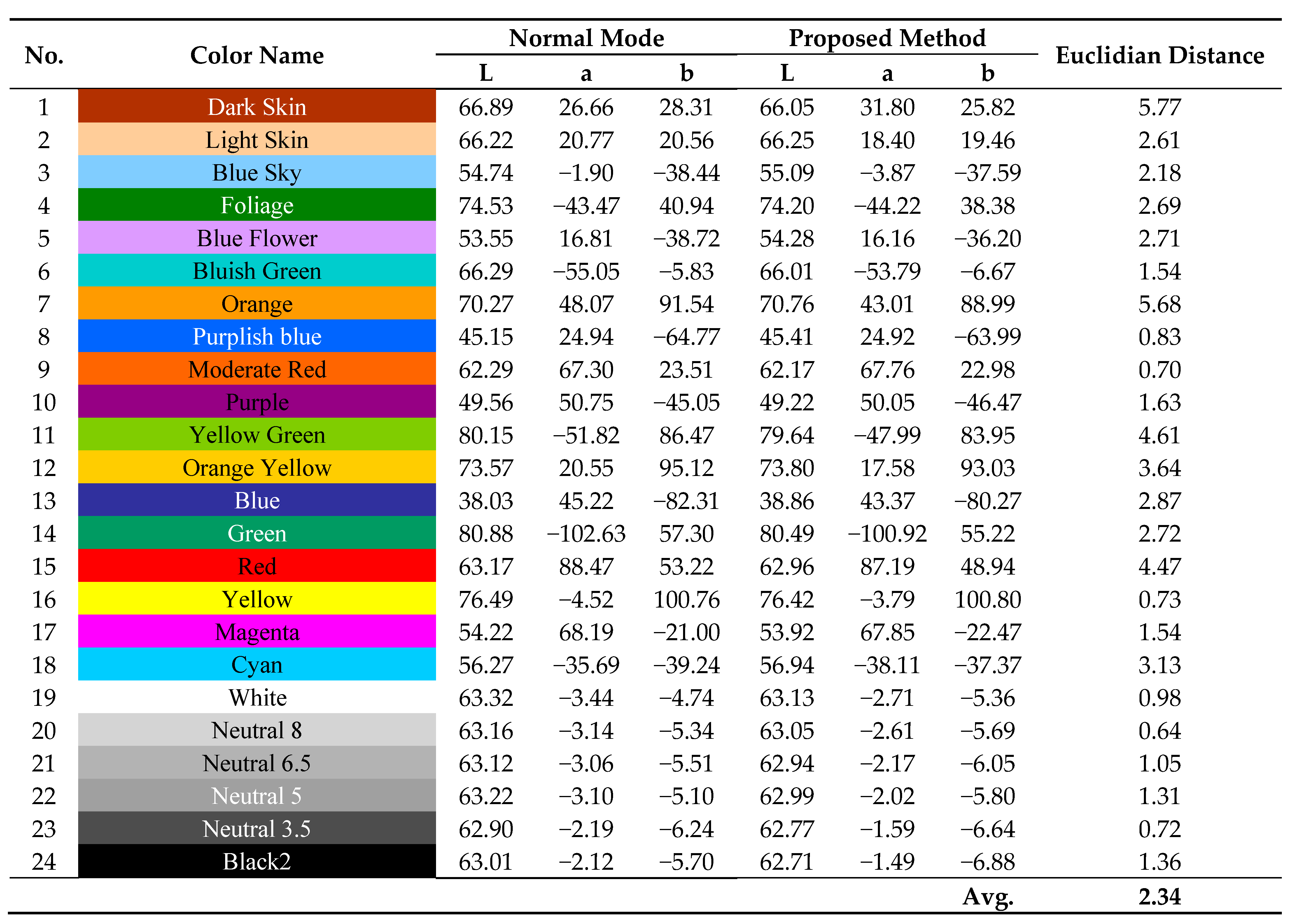
| Image Database | Reinhard Local TMO | Reinhard Global TMO | Reinhard Global TMO + UM |
|---|---|---|---|
| 15 images [30] | 14.36 | 0.83 | 1.40 |
| 10 images [35] | 9.08 | 0.54 | 0.97 |
| Avg. | 0.94 | 0.05 | 0.09 |
| Normal | LGC-DVS | Proposed Method | |||
|---|---|---|---|---|---|
| Power (mW) | Power (mW) | Power Saving (%) | Power (mW) | Power Saving (%) | |
| TMO images | 295.89 | 151.84 | 45.51 | 174.29 | 37.66 |
| LDR images | 251.69 | 134.75 | 44.21 | 148.91 | 37.20 |
| Avg. | 269.38 | 141.59 | 44.73 | 159.07 | 37.38 |
Publisher’s Note: MDPI stays neutral with regard to jurisdictional claims in published maps and institutional affiliations. |
© 2021 by the authors. Licensee MDPI, Basel, Switzerland. This article is an open access article distributed under the terms and conditions of the Creative Commons Attribution (CC BY) license (https://creativecommons.org/licenses/by/4.0/).
Share and Cite
Suh, S.; Hong, S.M.; Kim, Y.-J.; Park, J.S. Human Perceptuality-Aware Tone-Mapping-Based Dynamic Voltage Scaling for an AMOLED Display Smartphone. Electronics 2021, 10, 1015. https://doi.org/10.3390/electronics10091015
Suh S, Hong SM, Kim Y-J, Park JS. Human Perceptuality-Aware Tone-Mapping-Based Dynamic Voltage Scaling for an AMOLED Display Smartphone. Electronics. 2021; 10(9):1015. https://doi.org/10.3390/electronics10091015
Chicago/Turabian StyleSuh, Simon, Seok Min Hong, Young-Jin Kim, and Jong Sung Park. 2021. "Human Perceptuality-Aware Tone-Mapping-Based Dynamic Voltage Scaling for an AMOLED Display Smartphone" Electronics 10, no. 9: 1015. https://doi.org/10.3390/electronics10091015
APA StyleSuh, S., Hong, S. M., Kim, Y.-J., & Park, J. S. (2021). Human Perceptuality-Aware Tone-Mapping-Based Dynamic Voltage Scaling for an AMOLED Display Smartphone. Electronics, 10(9), 1015. https://doi.org/10.3390/electronics10091015







